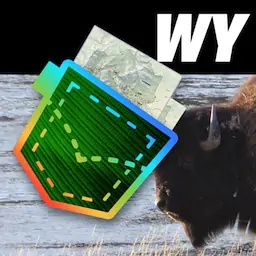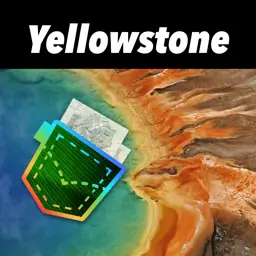150th Anniversary Visitor Guide InsertYellowstone Guide |
The 150th Anniversary Visitor Guide Insert for Yellowstone National Park (NP) in Idaho, Montana and Wyoming. Published by the National Park Service (NPS).
featured in
| National Parks Pocket Maps |  | |
| Idaho Pocket Maps |  | |
| Montana Pocket Map |  | |
| Wyoming Pocket Maps |  | |
| Yellowstone Pocket Maps |  |
1872
2022
Tales of a vast, mysterious plateau in
the Mountain West began to spread
across a young United States in the early 1800s. This Yellowstone country was
said to have a huge lake with waters as
clear as crystal, open fields dotted with
cone-shaped mounds holding boiling
water, and vents from which sulfur
issued forth.
By the late 1860s, formal expeditions
to explore Yellowstone were launched,
culminating in the 1871 Hayden Expedition. Led by Ferdinand V. Hayden,
the survey team included not only
scientists from a range of disciplines,
but also artists Thomas Moran, Henry
W. Elliot, and William Henry Jackson
(who painted the image above.)
The wonders of Yellowstone captured
the imagination of Congress. On
March 1, 1872, President Ulysses S.
Grant signed the Yellowstone National
Park Protection Act into law. The first
US national park was born, and with it,
an international movement to protect
places for their intrinsic and recreational value. The Act stated "[t]hat
the tract of land in the Territories of
Montana and Wyoming, lying near the
headwaters of the Yellowstone River
[...] is hereby reserved and withdrawn
from settlement, occupancy, or sale
under the laws of the United States, and
dedicated and set apart as a public park
or pleasuring-ground for the benefit
and enjoyment of the people."
Yellowstone's 27 Associated Tribes
Colville
Reservation
WA
Blackfeet
Turtle Mountain
Band of Chippewa
Gros Ventre
A-a-ni-nin
Assiniboine
Nakoda
Coeur d’Alene
Salish-Kootenai
Schitsu ‘umsh
Nakoda
Sioux
Dakoda/Lakota
MT
Nez Perce
Umatilla
Reservation
ND
Assiniboine
Nimiipuu
Northern
Cheyenne
Crow
Apsaalooké
Lakota
Standing
Rock
Sioux
Cheyenne
River
Sioux
Lakota
YNP
OR
Spirit Lake
Sisseton
Wahpeton
Oyate
SD
Lower
Brule
Sioux
Flandreau
Santee Sious
Dakota
Crow
Creek
Sioux
ID
Eastern Shoshone
Northern Arapaho
Shoshone-Bannock
WY
plus Kiowa in Anadarko, Oklahoma
Comanche in Lawton, Oklahoma
Little Shell Chippewa without a reservation
Yet the area set apart wasn't a pristine
unpeopled wilderness. For at least
11,000 years—long before European
Americans had set foot in the region or
even North America—Yellowstone was
home to a diverse array of cultures, as
evidenced by nearly 2,000 documented
archeological sites, trails (many still in
use), and campsites.
Oglala
Sioux
Rosebud
Sioux
Yankton
Sioux
Sičháŋğu Oyáte
North
0
0
Ancestors to today's 27 associated
tribes, whose names and current tribal
lands are shown in the map above, traveled trails, visited geysers, conducted
ceremonies, hunted, gathered plants
and minerals, and engaged in trade.
The Tukudika (Sheep Eater), a band of
Mountain Shoshone, even lived yearround in what is now the national park.
When Yellowstone National Park was
established in 1872, Native Americans
were left out of historical accounts and
discouraged from entering the park.
A band of 800 Nez Perce fled the US
Army through the park in 1877 (their
flight is commemorated in various
areas of the park). Tourism and industry were favored over traditional use.
100 Kilometers
100 Miles
Now, the park strives to recognize
this difficult history and to more fully
engage with Tribal Nations to honor
and learn from their ancestral connections. Learn more by visiting the Yellowstone Tribal Heritage Center at Old
Faithful (see page 14), engaging with
park exhibits and brochures, and visiting go.nps.gov/Yellowstone150.
Yellowstone: 1872 to 1947
A Park is Founded
Stagecoaches, Trains, Grand Hotels Autos, National Park Service
Although the US government saw fit to set aside YelBy the 1890s, more visitors began showing up to the
lowstone in 1872, it didn't see fit to set aside any funds park. Like visitors to this day, they needed transporfor its care.
tation, lodging, and food during their visit.
After years spent widening and improving roads and
bridges to accommodate the recently invented and
increasingly popular automobile, the first auto was
officially allowed in the park on July 31, 1915.
The park's first superintendent, Nathaniel P. LangVisitors during this time arrived to the park by train,
ford, received no pay, didn't live on site (he visited the then transferred to stagecoaches like the one picpark at least twice in his five years as superintendent), tured below at the Gardiner Train Depot in 1904.
and had no money to build basic structures and hire
law enforcement rangers.
But in 1878, one year after Philetus W. Norris was
appointed the second superintendent, Congress
authorized appropriations "to protect, preserve, and
improve the Park."
Norris constructed roads, built a park headquarters
at Mammoth Hot Springs, hired the first "gamekeeper," and campaigned against hunters and vandals. Much of the primitive road system he laid out
remains as today's Grand Loop Road. He also actively discouraged Native Americans from visiting the
park.
By 1886, it was clear that more resources would be
needed to manage and protect the park. The Secretary of the Interior, under authority given by the
Congress, called on the Secretary of War for assistance. On August 20, 1886, the US Army took charge
of Yellowstone. It strengthened, posted, and enforced
regulations in the park. Troops guarded the major
attractions and evicted troublemakers. Cavalry
patrolled the vast interior for poachers, whose activities threatened to exterminate animals such as the
bison.
Today, you can see buildings from and learn about
the Army era at Fort Yellowstone in Mammoth Hot
Springs (see page 17).
The automobile forever changed the nature of park
visitation. General stores and service stations were
built to meet the needs of auto travelers. The largest
impact can be clearly seen in the chart at bottom:
while visiting Yellowstone during the train and stagecoach era was quite expensive and thus mostly limited to the elite, autos made park tourism affordable for
a growing segment of the population. Visitation more
than doubled the first year that autos were allowed,
climbing to over half a million visits per year by 1940.
Another new development that would forever change
Yellowstone National Park came just a year later: the
creation of the National Park Service (NPS).
Since stagecoaches were much slower than modern
automobiles, hotels were built approximately a day's
stagecoach trip apart. While many early hotels are no
longer standing, some of these grand structures still
operate today, offering you a taste of the early visitor
experience. These include Lake Hotel (opened 1891),
the oldest still-operating hotel in Yellowstone; and Old
Faithful Inn (opened 1904), an architectural icon of
Yellowstone and the American West.
Running a park wasn't the Army's usual line of work.
While troops could protect the park and ensure
access, they couldn't fully satisfy visitors' desire for
knowledge. Moreover, each of the 14 other national
parks established in the late 1800s and early 1900s
was separately administered, resulting in uneven
management, inefficiency, and a lack of direction.
National parks clearly needed coordinated administration by professionals attuned to the special
requirements of these preserves.
Another significant piece of architecture was built
during this time: Roosevelt Arch. Dedicated in 1903 by
President Theodore Roosevelt, the arch still proudly stands just outside Gardiner, MT, near the park's
North Entrance.
The National Park Service Organic Act was passed by
Congress and approved by President Woodrow Wilson on August 25, 1916. This new agency fully took
over Yellowstone operations in 1918.
The park's boundaries
were also adjusted in
1929 and 1932 to conform
more closely to natural
topographic features,
such as the ridgeline
of the Absaroka Range
along the east boundary.
This box represents
the original boundary
of Yellowstone National
Park. Adjustments were
made in 1929 and 1932.
US Army soldiers pose with bison heads taken from notorious
poacher Ed Howell, circa 1894.
46
1
44
19
42
19
40
19
38
19
36
19
34
19
32
19
30
19
28
19
26
19
24
19
22
19
20
19
18
19
16
19
14
19
12
19
10
19
08
19
06
19
04
19
02
19
00
19
98
19
96
18
94
18
92
18
90
18
88
18
86
18
84
18
82
18
80
18
78
18
76
18
74
18
18
18
72
This graph shows the number of park visits
recorded each year, from so few visits in the
early years that they don't even show up at
this scale to over 4.2 million visits in 2016.
Yellowstone: 1948 to 2020
Ecosystem Management
4 Million Visits... and Beyond
World War II drew away employees, visitors, and
money from all national parks, including Yellowstone. Projects were halted, and infrastructure deteriorated. However, visitation jumped as soon as the
war ended, with the park recording more than 1 million visits for the first time in 1948. The park wasn't
equipped to meet this surging demand.
A growing understanding of ecosystems and the
interconnectedness of species led to changes in NPS
wildlife management policy. By the early 1970s, many
laws were passed to correct the mistakes of the past
and help prevent similar mistakes in the future.
Yellowstone had its first 3 million visit year in 1992.
4 million visits were recorded in 2015, just 13 years
later.
While Yellowstone National Park is vast—2.2 million
acres (8,980 km2)—most visitation is concentrated
within roads, buildings, and pullouts, an area covering far less than 1% of the park. And about 70% of
visitation occurs from June through August, further
concentrating use. As vistation continued to climb
during this period, park infrastructure became
strained, and crowded trails, roads, and parking lots
became more common.
One such law was the Endangered Species Act (1973). In
1975, grizzly bears were federally listed in the lower 48
states as a threatened species.
By 1978, all wolf subspecies were
on the federal list of endangered
species for the lower 48 states
except Minnesota.
In 1955, National Park Service Director Conrad
Wirth persuaded Congress to fund an improvement
program for completion by the NPS's 50th anniversary in 1966. Dubbed "Mission 66," the program
focused mainly on visitor facilities and roads. Work
in Yellowstone included the development of Canyon
Village, the first Mission 66 project initiated by the
NPS, which opened in July 1957.
Programs were created to restore both
populations. Grizzlies, still present in
the Yellowstone region, grew from a
population of 136 in 1975 to about
728 in 2020. Wolves, which had been
completely eliminated in Yellowstone by 1926, were reintroduced to
the park starting in 1995.
Yet the late 1990s–early 2000s was also a time of
deepening understanding of Yellowstone as the core
of an even greater region—the Greater Yellowstone
Ecosystem, one of the largest nearly intact natural
ecosystems remaining on the planet—and a need to
further study, protect, and, when necessary, rehabilitate key components of the ecosystem, from bison
populations to native fisheries.
The carefully studied recovery of these species has
had profound impacts on the Yellowstone ecosystem
and visitor experience. Learn more at go.nps.gov/
YELLmammals.
Canyon Village Lodge, 1957
The 1988 fires were another
reminder of the importance
of ecosystem-scale management. An incredible
event affecting almost
800,000 acres of the park,
the fires created a mosaic
of burns, partial burns,
and unburned areas. This
mosaic now provides
natural firebreaks and
sustains a great variety of
plant and animal species.
1959 brought a different kind of momentous change
to the park: on August 17, a magnitude 7.3 earthquake occurred, with its center just outside the park
boundary. The Hebgen Lake earthquake caused an
enormous landslide in the Madison Canyon, killing
28 people and trapping many tourists in the canyon
overnight. Many roads and buildings were damaged.
The effect of the earthquake on geothermal features
was spectacular. By the day after the earthquake,
at least 289 springs in the geyser basins of the Firehole River had erupted as geysers; of these, 160 were
springs with no previous record of eruption. Geysers
and pools throughout the park changed appearance
and behavior.
How will park managers respond to these and other
challenges as we embark on the next 150 years of
Yellowstone? Read on to find out.
4.5 M
4.0 M
3.5 M
3.0 M
2.5 M
2.0 M
1.5 M
1.0 M
0.5 M
20
18
20
16
20
14
20
12
20
10
20
08
20
06
20
04
20
02
20
00
20
98
20
96
19
94
19
92
19
90
19
88
19
86
19
84
19
82
19
80
19
78
19
76
19
74
19
72
19
70
19
68
19
66
19
64
19
62
19
60
19
58
19
56
19
54
19
52
19
50
19
48
0
19
19
Mission 66, Hebgen Lake Quake
Yellowstone: Today and into the Future
Yellowstone's 150th anniversary is an important
moment in time for the world—an opportunity to
reflect on the lessons of the past and to strengthen
Yellowstone for the future. Park managers' primary
goal is to continue making decisions that aim to protect the health of Yellowstone for centuries to come.
The park has developed a visitor use strategy that
focuses on preventing and mitigating resource
impacts, understanding and responding to impacts
on staffing and infrastructure, improving visitor
experience, and working with gateway communities
to continue facilitating recreational access and positive economic impacts.
To tackle the challenges of today, Yellowstone has
set five major strategic priorities, each supporting the overarching National Park Service (NPS)
mission and each critical to the success of Yellowstone National Park. These priorities are detailed
below, and in-depth information is available at
go.nps.gov/YELLstrategic.
You can be proud of the enormous amount of work
occurring in America’s first national park, none of
which can be done without your support. Thank you
for caring about and for Yellowstone.
Focusing on the CORE
This priority revolves around improving the working and living conditions
of the Yellowstone team, managing
financial resources, and working
toward the the most effective administrative and operating framework for
the park.
Major projects in this area include:
• Improving employee housing by
replacing trailers with high-quality
modular homes; improving non-trailer
housing units; rehabilitating deteriorating historic homes at Fort Yellowstone; and increasing housing capacity.
• Improving parkwide communications
and connectivity infrastructure.
• Streamlining park operating structure.
• Supporting the Yellowstone team
through a variety of operations
including an employee health and
wellness program.
Strengthening the Yellowstone Ecosystem and Heritage RESOURCES
This goal centers on strengthening,
preserving, and protecting Yellowstone's resources. The park is committed to being a world leader in
promoting large landscape conservation, understanding and responding to
the impacts of climate change, protecting resources from increasing visitor
use, and maintaining a robust scientific and research capacity to inform
resource-related decisions.
Areas of focus include:
• Continuing bison research and expanding the Bison Conservation Transfer
Program, which transfers brucello-
sis-free bison to tribal partners.
• Continuing to monitor and support
populations of wolves, cougars, grizzly
bears, and other key species.
• Suppressing nonnative lake trout in
Yellowstone Lake. Restoring streams.
• Preserving historic and cultural
resources.
Delivering a World-Class Visitor EXPERIENCE
This priority aims to provide clarity
Projects and goals include:
• Connecting to the public on the web,
and direction around how the park will • Gathering detailed data on visitor use
in social media, in the park, and in the
handle increased visitation in upcomand its impact on resources, operanews.
ing years—with special focus on visitor
tions, visitor experience, and impacts
• Protecting people and resources
impacts on resources, staffing and
to gateway communities.
through a wide variety of programs
infrastructure, visitor experience, and • Piloting studies and projects like visitor
including structural and wildland fire,
gateway communities.
shuttles, campground reservations,
search and rescue, public safety, and
and traffic management.
emergency medical services.
Investing in INFRASTRUCTURE
Yellowstone has assets valued at $3.8
billion, with a deferred maintenance
level estimated at over $700 million.
Actions include improving the deferred
maintenance reduction plan and taking
better advantage of current and future
funding to improve asset conditions
and protect investments.
Recent projects:
• Tower to Mount Washburn road improvement ($28 million), reopening
this summer.
• 40 new employee housing units
opening this year.
• Groundbreaking on projects totaling
more than $125 million this year through
the Great American Outdoors Act.
• Pelican Creek Bridge ($40 million).
• Norris to Golden Gate road
improvement ($30 million).
• Brink of the Upper Falls trail
improvement ($10 million).
• North Entrance station
improvement ($12 million).
Building Coalitions and PARTNERSHIPS
Yellowstone’s success is predicated on
strong partnerships and coalitions.
The park will continue to build and
align priorities with Tribal Nations and
a wide range of partners, elected officials, environmental and conservation
groups, concessioners, communities,
states, other federal cooperators, and
the philanthropic community.
tage Center project where tribal members will interact directly with visitors
about their cultures and heritage.
Recent developments:
• Tribes are also coordinating with
• Multiple Tribal Nations will be present
Yellowstone to install a large teepee
throughout the summer at Old Faithful
village in the park near the Roosevelt
as part of the Yellowstone Tribal HeriArch in August.





